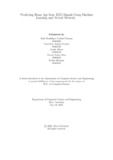| dc.contributor.advisor | Chakrabarty, Amitabha | |
| dc.contributor.advisor | Hossain, Muhammad Iqbal | |
| dc.contributor.author | Pratanu, Abul Mushfique Muslah | |
| dc.contributor.author | Farhad, Fuad Ibne Jashim | |
| dc.contributor.author | Afnan, Aysha | |
| dc.contributor.author | Mim, Nusrat Jahan | |
| dc.contributor.author | Rahman, Farhin | |
| dc.date.accessioned | 2023-04-06T05:08:52Z | |
| dc.date.available | 2023-04-06T05:08:52Z | |
| dc.date.copyright | 2022 | |
| dc.date.issued | 2022-05 | |
| dc.identifier.other | ID 18201183 | |
| dc.identifier.other | ID 18301229 | |
| dc.identifier.other | ID 18301039 | |
| dc.identifier.other | ID 18301003 | |
| dc.identifier.other | ID 18301001 | |
| dc.identifier.uri | http://hdl.handle.net/10361/18092 | |
| dc.description | This thesis is submitted in partial fulfillment of the requirements for the degree of Bachelor of Science in Computer Science, 2022. | en_US |
| dc.description | Cataloged from PDF version of thesis. | |
| dc.description | Includes bibliographical references (pages 50-53). | |
| dc.description.abstract | The objective of this study was to develop a technique for calculating the ages of people’s
brains by analyzing EEG data signals and using machine learning algorithms
on a Raspberry Pi. We employed many machine learning techniques, including random
forest (RF), Decision Tree Classifier, K Nearest Neighbors Classifier (K-NN),
Gaussian Naive Bayes, and Multi-layer Perceptron classifier(MLP). K-NN stands
for K-nearest Neighbors, whereas RF stands for Random Forest. We initially implemented
our machine learning algorithms on a desktop computer with many bells
and whistles, where the dataset was also trained. By applying the Random Forest
classifier (RF), we were able to attain 90% accuracy, the maximum feasible. The
K-Nearest Neighbors classifier placed second with an accuracy of 87%. The accuracy
obtained by the Decision Tree Classifier, the Naive Bayes algorithm, and the MLP
algorithm, in order, was 83%, 39%, and 40%, respectively. Our major aim was the
creation of an Internet of Things-based device, we tested our data on Raspberry Pi.
If in the future, we were to construct, based on our model, a device that rapidly
turned EEG brain signals into the participant’s brain age, we would be able to significantly
improve the quality of our work. In addition, it will aid in the diagnosis
of some brain illnesses at an early stage, which has been a struggle up until now. | en_US |
| dc.description.statementofresponsibility | Abul Mushfique Muslah Pratanu | |
| dc.description.statementofresponsibility | Fuad Ibne Jashim Farhad | |
| dc.description.statementofresponsibility | Aysha Afnan | |
| dc.description.statementofresponsibility | Nusrat Jahan Mim | |
| dc.description.statementofresponsibility | Farhin Rahman | |
| dc.format.extent | 53 pages | |
| dc.language.iso | en | en_US |
| dc.publisher | Brac University | en_US |
| dc.rights | Brac University theses are protected by copyright. They may be viewed from this source for any purpose, but reproduction or distribution in any format is prohibited without written permission. | |
| dc.subject | EEG | en_US |
| dc.subject | Brain age | en_US |
| dc.subject | K-NN | en_US |
| dc.subject | RF | en_US |
| dc.subject | Decision tree | en_US |
| dc.subject | MLP | en_US |
| dc.subject | Naive bayes | en_US |
| dc.subject | Raspberry Pi | en_US |
| dc.subject.lcsh | Machine learning | |
| dc.subject.lcsh | Neural networks (Computer science) | |
| dc.title | Predicting brain age from EEG signals using machine learning and neural network | en_US |
| dc.type | Thesis | en_US |
| dc.contributor.department | Department of Computer Science and Engineering, Brac University | |
| dc.description.degree | B. Computer Science | |

